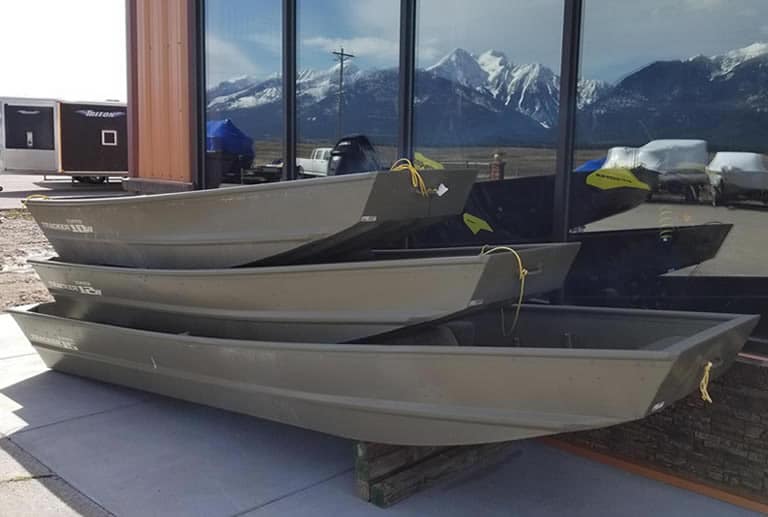Contents
- How do you buy the best Jon boat for your needs?
- How to choose the best motor for a Jon boat (often bought separately)
- The best Jon boat manufacturers & top Jon boat brands
- Tips for buying the best used Jon boat
How do you buy the best Jon boat for your needs?
First determine the best length of boat for your needs and then decide on the most appropriate construction material.
You may also want your boat to have certain add-ons for specific purposes, such as fishing for example.
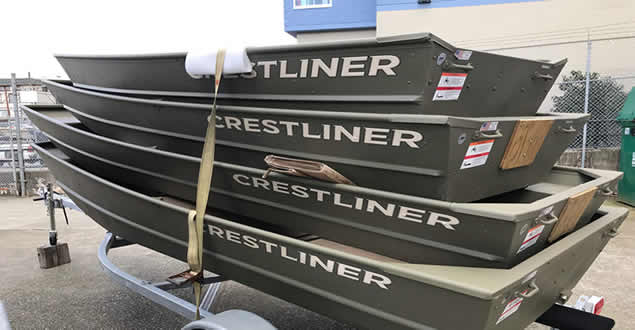
When buying a used Jon boat you must perform specific checks to ensure the boat is problem-free.
How to find the best Jon boat for your needs
There are different procedures to follow for buying a new Jon boat and buying a used one.
Obviously buying a used Jon boat requires a lot more diligence and attention to detail as you check the boat for possible problems.
I will cover the process for checking a used boat in detail later in this article.
Before embarking on a quest to find the perfect Jon boat you must first determine the size of the boat and the best construction material suitable for the types of environments the boat will operate in.
For the most part, all construction materials are equally as good for most tasks though some will wear much better in certain environments.
For example, an aluminum boat will corrode much quicker in saltwater than a wooden or fiberglass boat.
You need to buy a Jon boat because it’s the best flat bottom boat for shallow water
Jon boats have a flat bottom hull that is designed to give the boat a shallow draft and exceptional stability in calm water.
Some of the best Jon boats have a a semi-v hull modified design. This modification to the basic hull design offers the boat more stability in challenging weather and waves while allowing it to still access the type of shallower waters that a full v-hull boat could not.
On a semi-v hull the front of the Jon boat is shaped in the form of a “V” that allows the vessel to cut through choppy waters and so provides a safer and more comfortable ride in those conditions.
If the chop on the water goes above the height of the bow then a modified v-hull would be much smoother and provide a drier safer ride than a standard Jon boat hull.
Its semi-v bottom offers more stability in choppy water than the standard flat bottom does because it can cut through chop better.
If the chop is regularly over your bow then you are probably best not getting aa flat bottom boat at all. In such marine environments it would be better seeking a boat with a full-v (as long as it can safely navigate the waters you use i.e. they are not to shallow for a v-hull).
If you do regularly experience chop in shallow waters then a semi-v Jon boat is a better option than a standard Jon.
But, if you only navigate shallow calm waterways then a standard flat-bottomed Jon boat will offer you more stability, better access to very shallow areas and a more comfortable ride at speed.
The size of Jon boat you need depends on your specific needs
The best Jon boat for you will be one that fits your individual needs.
I know this sound obvious but you would be surprised by how man boat owners are swayed by marketing tactics and price tags when making a purchase.
The bigger or more expensive boat is not always the best choice for you.
To determine the best length of Jon boat you need you must give consideration to the specific purpose of the boat.
Your decision of Jon boat size will also largely depend on the location in which you use the boat rather than the specific purpose.
Large boat lengths lend themselves better to certain activities, due to passenger count and amount of gear stored onboard etc. But a large boat may cause you trouble when you attempt to navigate tight bends or when you want to access some sloughs, for example.
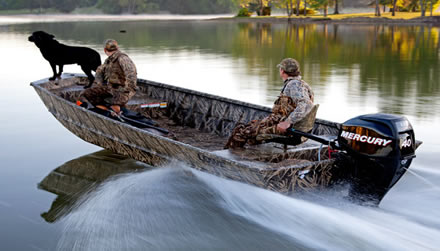
Keep in mind that larger, and wider, Jon boats ride choppy water much better than smaller ones.
Keeping in mind that the environment plays a major role in the choice of Jon boat size here we will delve into the best sizes for the most common activities associated with the best Jon boats.
The best Jon boat for hunting
As with every boat there are pros and cons to using different sized Jon boats.
For example, a large 20 foot Jon boat will allow you to store a lot more equipment but a smaller 10 foot boat is easier to hide when hunting.
A smaller boat is also a lot easier to push off sandbars than a larger one as well.
If you plan to hunt in packs then a smaller Jon boat would be impractical. Even 1 person on a 10 foot Jon boat with full duck hunting gear can make the boat feel rather cramped.
While a 17 foot Jon boat should be able to accommodate 3 experienced men with gear, in optimal weather conditions, if the weather turns bad or you have inexperienced passengers onboard you could run into trouble on the stability front.
It will probably also feel a bit crowded.
A 18 foot Jon boat should be big enough to haul dogs and decoys in large lakes. It should also be stable enough to handle fairly rough waters (within reason).
If you hunt in small lakes and ponds then a small Jon boat, 10 foot or 12 foot, will be more than enough for the job.
Many hunters argue that a semi-v hull is better than a flat bottom but bear in mind that this will cause problems should you need to access very shallow areas such as banks.
We recommend sticking to a boat with a flat bottomed hull as it has a very shallow draft that will allow you access to many more hunting areas.
The best Jon boat for bass fishing & angling
Although most bass fishermen prefer to use a Bass boat, Jon boats are still very popular because they can be used for other activities as well.
The best Jon boats can easily be used for bass fishing.
The same rules apply to using a Jon boat for fishing as they do for duck hunting. So, answer the following questions:
- How many people will be on the boat?
- How much gear will you be carrying?
- How large are the bodies of water you will be fishing in?
Unlike hunting, which requires a bigger boat, small Jon boats fare quite well when it comes to fishing.
However, the same thing applies when fishing on a Jon boat the size of your boat largely depends on the size of the waters you are fishing.
The best Jon boat for bowfishing
Flat bottom boats are perfect for bowfishing as the shallow draft of the boat lets it access areas that deeper draft boats could not enter (read more about shallow draft vs deep draft here).
They are also exceptionally stable in calm water.
The flat bottom design also makes it easier to add a shooting platform on the deck as shown in the image below.
As with bass fishing and duck hunting you need to consider the size of the bodies of water that you intend to fish in as this will determine the best size of Jon boat.
Aluminum Jon boats are a very popular choice for bowfishing.
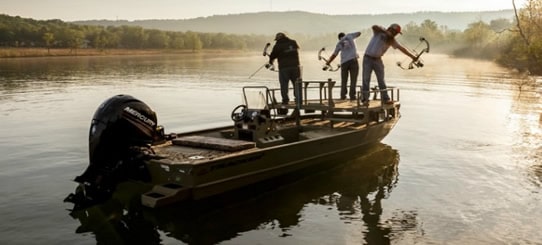
Although aluminum is exceptionally long lasting in freshwater it corrodes easily in saltwater.
So, if you intend to also use your boat in saltwater you may be better with a fiberglass boat (or you can build your own wooden boat as we demonstrated here).
Be aware that a Jon boat is not the only choice for this type of activity though they are by far the most popular.
For example, a fiberglass flat-bottomed skiff is also very popular among anglers for bowfishing.
As most of skiffs will be powered by a trolling motor you need to take that into account when accessing shallow water. The boat will have a deeper draft due to the propeller (whereas a Jon boat can have its engine disengaged and be moved via manual propulsion in very shallow areas).
Pontoon boats also serve really well as bowfishing vessels as they are both very stable in calm waters and offer a very wide platform to shoot from.
A pontoon boat gives you the added advantage of installing more lights should you wish to bowfish in failing light or at night.
Although the same basic rules apply to buying a bowfishing Jon boat as apply when wanting a boat for bass fishing or hunting, when it comes to bowfishing you should really go for the biggest boat you can afford.
A larger boat offers more stability and will give you much more room and space to move thus helping to improve your shot accuracy.
It is unlikely you will buy a Jon boat, new or used, that has already been setup for bowfishing.
So before you choose one make sure it can accommodate all your equipment, if using lights for instance, and that it offers enough stability and room for accurate shooting.
Although it is not a major requirement for a bowfishing boat it is advantageous to have a deck or a platform on the boat with enough space for you to aim and shoot.
On a Jon boat without a modified shooting deck you can still stand on the deck or the seats to aim your shots and the boat should remain very stable while in calm water.
Bass fishing & bowfishing off a Jon boat (video)
How to choose the best motor for a Jon boat (often bought separately)
The answer to this question is simple for many – “the bigger the better” is often the war cry of Jon boat owners!
However, this is not always the best option as you will see.
From the perspective of some Jon boat owners you will hear enthusiasts say that “there is a trend for settling on their outboard motor”, meaning they settle for small engines.
It is true that many Jon boat buyers will settle for a smaller motor when the boat they are buying is capable of accommodating a bigger one.
Some enthusiasts argue that new buyer’s are selling themselves short by settling for a smaller motor when their boat can handle something much bigger.
Although this may be true if the Jon boat is being used as a utility boat or for transportation, or even if there are large areas between hunting or fishing grounds, it is not always a good idea to get a bigger motor.
Why?
Because big engines create big noise.
Most hunters and anglers will prefer a reliable, quieter engine over a more powerful counterpart for obvious reasons.
A noisy engine will scare away fish and airborne prey alike and big engines can be heard from a fairly long distance away.
So the rule-of-thumb is to get as big an outboard motor as your Jon boat can handle, especially if you need speed or you travel long distances in your boat, but if you hunt or fish in relatively small waters a smaller quieter motor is a better choice.
For this reason when it comes to bass fishing and bowfishing many Jon boat owners prefer quiet engines.
They will also ensure their boat has additional manual means of propulsion such as oars or a paddle so they can navigate hunting areas quietly.
You read our extensive guide on choosing an appropriate outboard in our Jon boat motor guide.
On that note, regardless of what size of motor you use, you should always have some form manual propulsion in your boat for safety reasons as we outlined in the article how to drive a flat bottom boat.
The best Jon boat manufacturers & top Jon boat brands
There are many different manufacturers of Jon boats.
Below is a list of the most popular and best Jon boat brands on the market at this time.
The top 8 aluminum Jon boat manufacturers
Arguably the most popular manufacturers of aluminum Jon boats are Lund, Lowes and Tracker though there are other companies that make boats equally as well.
Some of these manufacturer’s have a range of bowfishing Jon boats as well as standard Jon boats and flat bottom skiffs.
Of course there are other manufacturers and you should shop around for the best deal on the boat that fits your particular needs best.
Don’t be afraid to go for a none brand name if you find a boat that fits your specific needs best.
The top 6 fiberglass Jon boat manufacturers
Fiberglass Jon boats are much less popular than aluminum ones.
You will find some one sale online that are unbranded but they are few and far between.
It is much easier to find fiberglass flat-bottom skiffs.
- Kencraft. Their Bay Rider range are marketed as skiffs but the design is more like a Jon boat such as the 1660 Duck Rider Edition.
- River Hawk. Great range of flat bottom skiffs. Their duck boats are semi-v Jon boats.
- Stalker.
- Stumpnocker.
- Carolina Skiff
- Jones Brothers. Make great bateau boats. To learn more about this unique boat type read this.
Lund’s best Jon boats
Lund has a wide range of Jon boats. They start at 10 foot and incrementally increase in size up to 18 foot.
Lund Jon boats are made from aluminum making them very durable, expect in saltwater. Saltwater corrodes aluminum much quicker than other materials.
If you plan to take your boat in saltwater you would be better with a wooden or fiberglass Jon boat.
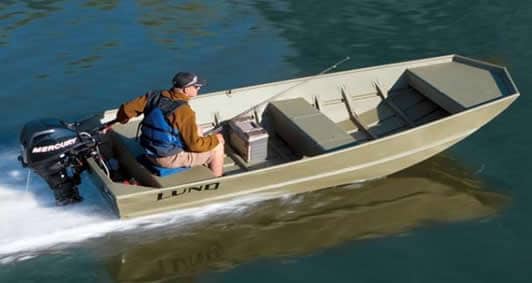
If you plan to take your Jon boat into the ocean I strongly recommend you read the article can Jon boats go in the ocean as there are real safety concerns about doing this.
All Lund Jon boats offer great quality and durability and your choice of vessel will depend on the size of boat you need.
Boater’s Chat ran a comparison to see if Lund boats lived up to the hype and found that Lund have failed to stay on top of new innovations, instead they have decided to rest on past glories.
It seems Lund is no longer the best Jon boat manufacturer though their boats are just as good as other, sometimes cheaper, brands. So shop around.
Tracker’s best Jon boats
Tracker Jon boats are very popular and they are one of the best Jon boat brands in the marketplace for good reason.
They make some of the best Jon boats available.
They have a wide range of Jon boats to suit every purpose and wallet.
What we love about Tracker boats is that they offer models that are designed to be suited to specific activities.
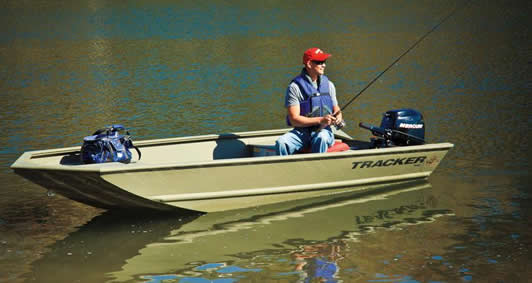
Here are a few examples of the best Tracker Jon boats:
Topper 1036
- Great entry level Jon boat.
- Flat-bottom, solidly riveted aluminum hull.
- Length: 9 foot 10 inches.
- Beam: 4 foot 4 inches.
- 2 person.
- Durable Forest Green powder-coat finish for good looks & a long life.
- .050 gauge 5052 marine aluminum alloy.
- Pressed-in longitudinal corrugation.
- Corner braces at transom.
- 2 bench seats (center & aft).
- Underseat foam flotation adds safety in event of capsizing (see why here).
- Bow & stern handles for lifting.
- 3-year limited warranty on riveted structure.
- Available w/optional trailer.
A very reasonably priced entry-level Jon boat.
Check out the Topper 1036 on the Tracker website.
GRIZZLY® 1654 T Sportsman
- Duck hunter Jon boat.
- Length: 17 foot 4 inches.
- Beam: 6 foot 6 inches.
- 4 person.
- Aluminum construction.
- Lockable, top-loading bow deck storage compartment.
- Port storage box & lockable, removable starboard gun box.
- Exclusive VERSATRACK® accessory-mounting channel in gunnels
- Exclusive Forest Green Sure Tread™ powder-coat.
- 7° deadrise, all-welded modified v-hull for great handling & a smoother, drier ride in choppy conditions.
- Stringer system & transom welded into the .100 5052 aluminum alloy hull.
- Welded-in, foam-filled interior side walls for quieter ride & structural strength and easy retrieval if capsized.
- Custom-fit trailer w/GALVASHIELD® Impact corrosion & chip protection.
A high-end boat that’s ideal for group ducking hunting.
See the GRIZZLY® 1654 T Sportsman on the Tracker website.
GRIZZLY® 2072 CC Sportsman
- Bowfishing Jon boat.
- Length: 21.5 foot.
- Beam: 8 foot 6 inches.
- 5 person.
- Aluminum construction.
- Minn Kota® PowerDrive™ 12V, 55-lb. thrust, 54″ shaft, foot-control trolling motor.
- Removable 40,000-lumen bow LED light kit powered by an onboard generator.
- Elevated, removable shooting deck w/2 seat bases & arrow/drink holders.
- Integrated sponsons at the stern for quick planing & shallow-water performance.
- Exclusive VERSATRACK® accessory-mounting channel in gunnels.
- Exclusive Forest Green Sure Tread™ powder-coat.
- Foam-filled interior side walls, adds safety in event of capsizing and offers a quieter ride.
- Custom-fit trailer w/GALVASHIELD® Impact corrosion & chip protection.
A top-of-the-range Jon boat for serious water enthusiasts. This boat isn’t cheap but it’s worth every penny.
See the GRIZZLY® 2072 CC Sportsman on the Tracker website.
Lowe’s best Jon boats
Lowe makes some really good Jon boats from entry-level vessels to larger more expensive models.
Some of their larger boast are among the best Jon boats out there.
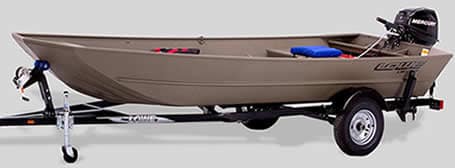
Here are a few examples of some great Lowe Jon boats:
Little Jon 1032
- Economical to own.
- Length: 10 foot.
- Beam: 4 foot.
- 2 person.
- Aluminum construction.
- Easy to power.
- Excellent entry-level Jon for fishing, hunting and light utility work.
- Flat bow.
- 15” transom.
- Formed-in keels.
- Transom corner caps.
- Durable paint finish.
This great little Jon boat starts at under $750 for the base model making it super value for money.
See the Little Jon (L1032) at Lowes website.
L1448T Little Jon
- Economical to own.
- Length: 13 foot 8 inches.
- Beam: 5 foot 10 inches.
- 4 person.
- Aluminum construction.
- Easy to power.
- Excellent Jon for fishing hunting and utility work.
- Formed-in keels.
- Strong lifting handles.
- Deep 20” transom height.
- Durable paint finish.
A well-priced Jon boat that is suitable for all Jon boat activities.
See the L1448T Little Jon at Lowes website.
L1648M Big Jon
- Economical to own.
- Length: 15 foot 8.5 inches.
- Beam: 5 foot 10 inches.
- 4 person.
- Aluminum construction.
- Excellent Jon for fishing, hunting and utility work.
- Convenient handles.
- Deep 20” transom height.
- Spacious bench seats.
- Flat-bottom with semi-v hull.
- Durable paint finish.
Check out the Big Jon at Lowes website.
How much you can expect to pay for a new Jon boat
The cost of buying a new Jon boat will depend on the make, the size and the construction material used on the boat.
For example, a 12 ft polythene Jon boat can be bought for as little as $550 while a larger 18 ft aluminum Jon boat can cost as much as $4000.
You can also make your own plywood Jon boat for just the cost of materials as we demonstrated here.
For a rundown of costs associated with specific Jon boats read the article How Much Does a Jon Boat Cost.
Tips for buying the best used Jon boat
Sometimes your budget just won’t stretch to a new boat.
Even if you have the funds available for a new small or medium sized boat it may be more advantageous for you to consider a larger used Jon boat.
When it comes to buying a used boat you need to inspect the vessel properly before ever handing over any money.
Below are some checks you should perform on every used Jon boat you are considering buying.
- Check for cracks and leaks.
- Look for previous repairs.
- Test for corrosion.
- Check the transom.
- Check the oar locks (if installed).
- Check for loose seating.
- Check the engine.
- Test the oil.
Let’s look at these in more detail.
Inspect boat for cracks and leaks
Small hairline cracks, especially in fiberglass boats, are not usually that big of a deal and are often just cosmetic in nature.
Cosmetic cracks can be easily fixed by applying a simple fiberglass fill or by using a cheap fiberglass repair kit like this one.
However, if a crack is larger than 2 inches beware! Large cracks may be an indication of much greater problems than mere cosmetics.
Large cracks are often an indication that a collision has occurred.
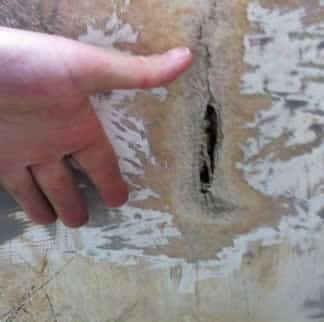
In addition to large cracks (or multiple cracks all over the boat), a mold build-up is also a bad sign.
As is, bending and also the presence of moisture in both fiberglass and wooden boats, such as in the hull, the transom, and the boat floor.
Any one of these could be a sign of rot in the wood, or deterioration of the fiberglass.
If you see any of these signs, walk away.
In the case of a plywood Jon boat mold can be an indication of delamination of the plywood.
A boat with these problems is not worth buying.
How to check for leaks
The following advice may seem a bit extreme to some readers but following it could mean the difference between you getting a great boat or buying a complete dud.
The boat will need to be positioned in some type of dry dock – on a trailer or stand for example. It should then be filled with water.
If the boat has leaks then these leaks will start to bleed water. If the boat is leaking quickly then extensive repairs are needed and that may be a sign of serious damage.
If the boat is fiberglass then it’s almost certainly not worth attempting to repair it.
However, if there are only small, slow leaks coming from a bolt or rivet these repairs are minor.
You should use them as an excuse to drive the price down though as it will cost you time and labor to fix them.
Look for signs of previous repairs
If there are signs of extensive repairs to the boat you will probably want to keep shopping around.
Large patches and different colored paintwork can be a sign of repair work.
Fiberglass filler patches are a strong indication of previous repairs.
Any signs of previous repair work need a specialist’s eye to determine how bad the previous damage was and if it has weakened the integrity of the boat.
If you can’t get a professional to look over the boat and give you an honest appraisal then it would probably be better not to buy.
Test for corrosion
Corrosion is bad. Corrosion on an aluminum boat will show in the form of peeling paint usually indicating the boat has been used in saltwater.
If you see a corroded area on the boat, press that area lightly with your finger to see how stable it is.
If it’s spongy that is a very bad sign.
If the area is very badly corroded you may even form a hole at that spot. If your finger goes through a part of the boat you press on walk away.
If the corrosion is superficial then you will probably be able to complete repairs yourself but if there is widespread or extensive damage then it is best to pass on the sale.
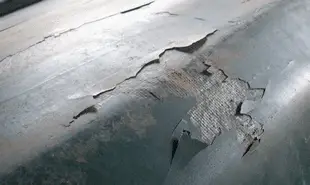
Check the transom
The transom is the place where very often cracks and rot will appear first.
So it is worth having a good look in that area.
If transom needs replaced then you can usually do it yourself reasonably cheaply but if you have to pay someone else to do it then it will become an expensive job.
Check the oar locks
Cracking and lose oarlocks can be a sign of corrosion or it may merely be due to loose bolt holes that have widened with use.
You will need to determine this yourself though corrosion is pretty easy to spot as are holes that have been widened.
If it’s corrosion, that is a bad sign.
If the bolts have merely widened the holes then you can fix them easily yourself with the correct filler material.
Make sure you use it as a price-bargaining chip though.
Check for loose seating
Just as lose oarlocks can be a sign of corrosion or widened holes, so too can loose seating.
If the holes have merely widened with use the fix is easy by using the appropriate filler material.
If the seats are loose due to corrosion you do not want the boat!
Start the engine
If the Jon boat comes with a motor make sure you start it up.
Does it start first time?
Look for smoke and listen for rattling noises or any sound that appears to indicate an unhealthy engine.
Test the oil
Be sure to test the oil.
If the oil has a gritty texture between finger and thumb it’s a sign of extensive engine wear.
The grit you are feeling is small metal shavings that have broken away from the engine as it runs.
If the oil has a milky texture then water is getting into the engine and it needs replaced.

